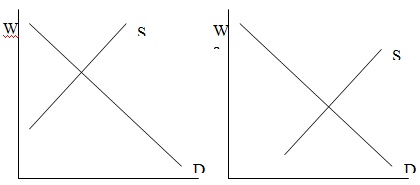Assignment:
1. a. Explain carefully: "If all workers and jobs were identical, there would be just one wage rate, assuming perfect information and costless mobility." As part of your answer, use the graphs to illustrate what would happen if wages were initially unequal. Be sure to explain the role of the assumptions regarding information and mobility. What happens if they are violated?

b. Discuss: "Many of the lowest-paid people in society- for example short-order cooks- also have relatively poor working conditions. Hence the theory of compensating wage differentials is disproved." Why do college professors typically earn less than their Ph.D. counterparts who are employed by corporations?
c. A study by Blau, Ferber, and Winkler in 1988 estimated that women in their sample earned only $.72 for every $1 earned by men (women in the sample earned 72 percent as much as men). Using principles of compensating wage differentials identify at least 5 factors that may explain at least part of the female-male pay gap. Explain your reasoning carefully.
2. Using the investment in human capital model developed in class explain the following:
a. Given the work-life cycle of "traditional" women, it may be rational for women to invest in less human capital than men.
b. An economic recession tends to increase college and graduate school enrollments.
c. If age-earnings profiles indicate that people with more education on average earn more than people with less education; therefore, personal spending on education is always a good investment.
d. It may be desirable for society to subsidize the costs of education if the benefits of education are greater from a societal perspective than a private perspective. Why is education sometimes considered a positive externality?
3. The demand for labor in Occupation A is LD= 20 - W, where LD = number of workers demanded for that occupation, in thousands. The supply of labor for Occupation A is LA = -1.25 + 0.5 W.
For Occupation B, the demand for labor is similar but the supply of labor is LB = -0.5 + 0.6 W, which is indicative of a more pleasant work environment associated with that occupation in comparison with Occupation A. Calculate the compensating wage differential between the two occupations?